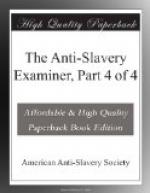The peculiar atrocity of this resolution was, that it not merely trampled upon the rights of the petitioners, but took from each member of the House his undoubted privilege, as a legislator of the District, to introduce any proposition he might think proper, for the protection of the slaves. In every Slave State there are laws affording, at least, some nominal protection to these unhappy beings; but, according to this resolution, slaves might be flayed alive in the streets of Washington, and no representative of the people could offer even a resolution for inquiry. And this vile outrage upon constitutional liberty was avowedly perpetrated “to repress agitation, to allay excitement, and re-establish harmony and tranquillity among the various sections of the Union!!”
But this strange opiate did not produce the stupefying effects anticipated from it. In 1836, the petitioners were only 37,000—the next session they numbered 110,000. Mr. Hawes, of Ky., now essayed to restore tranquillity, by gagging the uneasy multitude; but, alas! at the next Congress, more than 300,000 petitioners carried new terror to the hearts of the slaveholders. The next anodyne was prescribed by Mr. Patton, of Va., but its effect was to rouse from their stupor some of the Northern Legislatures, and to induce them to denounce his remedy as “a usurpation of power, a violation of the Constitution, subversive of the fundamental principles of the government, and at war with the prerogatives of the people."[105] It was now supposed that the people most be drugged by a northern man, and Atherton was found a fit instrument for this vile purpose; but the dose proved only the more nauseous and exciting from the foul hands by which it was administered.
[Footnote 105: Resolutions of Massachusetts and Connecticut, April and May, 1838.]
In these various outrages, although all action on the petitions was prohibited, the papers themselves were received and laid on the table, and therefore it was contended, that the right of petition had been preserved inviolate. But the slaveholders, maddened by the failure of all their devices, and fearing the influence which the mere sight of thousands and tens of thousands of petitions in behalf of liberty, would exert, and, taking advantage of the approaching presidential election to operate upon the selfishness of some northern members, have succeeded in crushing the right of petition itself.
That you may be the more sensible, fellow citizens, of the exceeding profligacy of the late RULE and of its palpable violation of both the spirit and the letter of the Constitution, which those who voted for it had sworn to support, suffer us to recall to your recollection a few historical facts.




